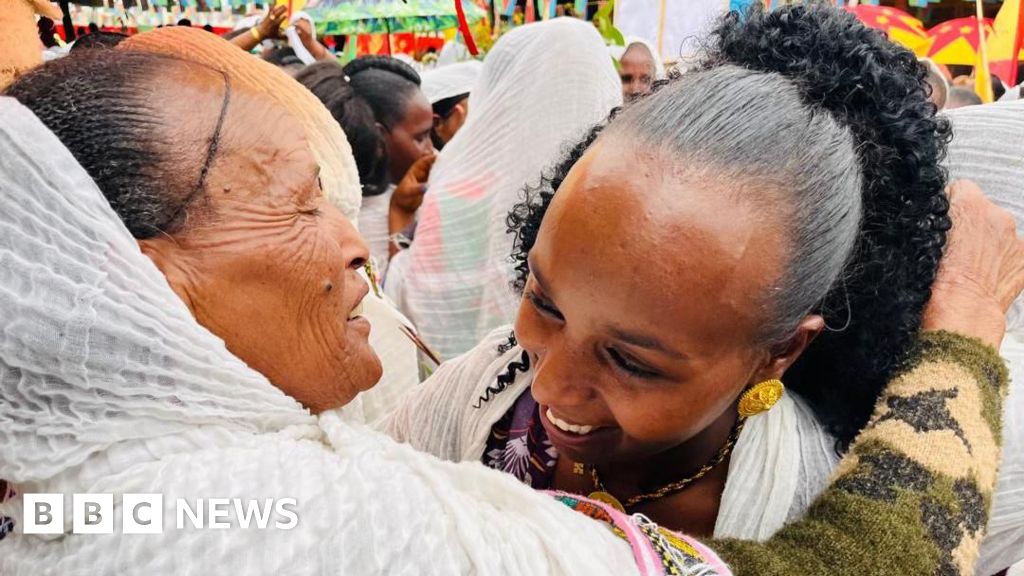Joyful Ethiopians and Eritreans embrace at rare border reopening

Ethiopia-Eritrea: Rare Border Reopening Sparks Hope Amid Lingering Tensions
Communities along the Ethiopia-Eritrea border have celebrated a rare, albeit unofficial, reopening of a section of the frontier, marking the first time in five years that families and friends have been able to reunite. The emotional gatherings took place in the Ethiopian town of Zalambessa on Sunday, offering a glimmer of hope for reconciliation after years of conflict and strained relations.
The border closure, exacerbated by the outbreak of the Tigray conflict in 2020, had separated communities and severely impacted livelihoods. While the move to reopen a section of the border was initiated by local activists and community leaders without formal government endorsement, organizers claim to have received tacit approval from officials in both Tigray and Eritrea.
A Symbolic Step Towards Peace
The reunions in Zalambessa were characterized by expressions of joy, relief, and a collective yearning for normalcy. Individuals waved flags of both Eritrea and Ethiopia's Tigray region, symbolizing a desire for unity and cooperation. Cross-border trade has also reportedly resumed, with residents using both Ethiopian and Eritrean currencies, further indicating a move towards pre-conflict conditions.
“As people, we want to eat, trade and attend social events as before. Their siblings are here, their siblings are there. What we need is peace,” one woman from Tigray told the BBC, highlighting the deep-seated desire for restored connections and economic stability.
Challenges Remain Despite Optimism
Despite the celebratory atmosphere, significant challenges impede a full return to normalcy. Zalambessa's infrastructure remains severely damaged, with essential services like electricity, telephone, and banking completely destroyed. The destruction, largely affecting infrastructure owned by the Ethiopian federal government, requires substantial investment for restoration.
Water, health, and education facilities, also impacted by the conflict, are slowly being rebuilt through the efforts of local communities and donor organizations. The widespread looting of property and destruction of homes further complicate the resettlement process for thousands of displaced families.
Historical Context and Expert Analysis
The Ethiopia-Eritrea border has been a source of tension for decades. Eritrea seceded from Ethiopia in 1993 after a long and bloody struggle. Relations remained fraught, with the border largely closed until 2018, when Ethiopian Prime Minister Abiy Ahmed initiated a peace agreement with Eritrean President Isaias Afwerki. This historic deal earned Abiy the Nobel Peace Prize, raising hopes for lasting peace.
However, the eruption of the Tigray conflict in November 2020 shattered these hopes. Eritrea’s involvement in the conflict on the side of the Ethiopian government further strained relations and led to renewed border closures. "The Eritrean intervention in Tigray was a major setback for regional stability," says Dr. Mehari Taddele Maru, a specialist in African governance and security. "It not only prolonged the conflict but also deepened mistrust between the two countries and their respective populations."
Uncertain Future for Governmental Reconciliation
While the local border reopening signifies a positive step at the community level, it remains unclear whether this initiative will translate into broader reconciliation between the governments of Ethiopia and Eritrea. Tensions persist, and the border remains officially closed despite the community-led efforts.
"This grassroots initiative is commendable, but it needs to be supported by concrete political steps from both governments," argues Semhar Ghebremichael, a Horn of Africa analyst. "Without a genuine commitment to dialogue and addressing the underlying issues, the progress made at the local level risks being undermined."
Looted property and destroyed homes hinder resettlement. Essential services like electricity and banking remain unavailable. The border remains officially closed by both governments.
Hope for the Future
Despite the challenges, the reopening of the Zalambessa border offers a tangible sign of hope for communities yearning for peace and reconciliation. As Nebiat Woldegergis, who traveled from Senafe, Eritrea, to attend the ceremony, stated, "I am confident that the peace and reconciliation we started today will continue to grow."
Amleset, a mother who had lived for five years in a refugee camp, echoed this sentiment: "Today I came to see my locked house. From now on, I will return with my children and continue living on my land."
The future of the Ethiopia-Eritrea relationship remains uncertain, but the actions of these communities demonstrate a powerful desire for a peaceful and prosperous future.
Originally sourced from: BBC News Africa
